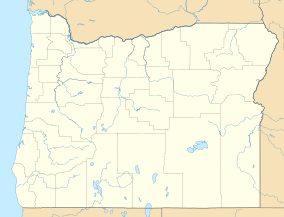Smith and Bybee Wetlands Natural Area facts for kids
Quick facts for kids Smith and Bybee Wetlands Natural Area |
|
|---|---|

Smith Lake from north shore, 2008
|
|
| Location | Portland, Multnomah, Oregon, United States |
| Area | 2,000 acres (8.1 km2) |
| Elevation | 20 ft (6.1 m) |
| Governing body | Metro Regional Government |
| Website | Smith and Bybee Wetlands |
The Smith and Bybee Wetlands Natural Area is a cool public park and nature reserve. You can find it in Portland, Oregon, right between the Columbia Slough and the Columbia River. It's super big, about 2,000 acres (810 ha)! This makes it one of the largest freshwater wetlands in a city in the whole United States.
The park is managed by Metro, which is the local government for the Portland area. Even though it's surrounded by busy port terminals and warehouses, it's a home for lots of amazing wildlife. You might spot beavers, bald eagles, and even western painted turtles here. A special water system helps keep the wetlands nice and wet for all the plants and animals.
Contents
Exploring Smith and Bybee Wetlands
This huge park is 2,000-acre (810 ha) and has many things for visitors. You'll find restrooms, signs that teach you about the area, and a covered picnic spot. There's also parking for about 40 cars and a place for buses to drop off visitors. Some cool public art is also on display near North Marine Drive. This road runs along the north side of the wetland.
Getting Around the Park
The parking lot is about 2.5 miles (4.0 km) west of the Delta Park – Marine Drive West exit from Interstate 5. From the parking lot, you can walk or roll on the Interlakes Trail. This paved path is great for wheelchairs and leads to two viewing platforms. From these spots, you can watch for wildlife between the lakes.
Boating and Biking Fun
If you like being on the water, you can use the park's canoe launch. You can bring your own non-motorized boat, like a canoe or kayak. It's a fun way to explore the lakes, watch animals, or even fish for certain types of fish. If you prefer biking or walking, there's a bike path along North Marine Drive. This path is part of Portland's bigger system of greenway trails called the 40-Mile Loop.
Plants and Animals of the Wetlands
The Smith and Bybee Wetlands are home to a wide variety of plants and animals. It's like a giant outdoor classroom!
Trees and Shrubs
The forests in the park are full of different trees. You'll see tall black cottonwood trees, Oregon ash, red alder, and big leaf maple. There are also many kinds of willows and other shrubs. Some of the ash trees are more than 100 years old! In the swampy areas, you'll find thickets of willow, red-osier dogwood, and other small shrubs like spiraea.
Grasses and Water Plants
Open meadows in the park have plants like sedges, rushes, beggars tick, rice cutgrass, and reed canary grass. The sloughs and ponds are filled with aquatic plants. These include beautiful pond lilies, tiny duckweed, and different kinds of algae.
Mammals and Reptiles
Many different mammals live in the park. Look for beavers, nutria, river otters, cottontail rabbits, raccoons, muskrats, mule deer, mink, and coyotes. The only reptiles you'll find here are garter snakes and turtles. There are over 200 western painted turtles! These turtles are a "sensitive-critical species" in Oregon. This means their numbers are going down, and they could become threatened or endangered if things don't improve.
Amphibians and Fish
You might also spot amphibians like salamanders and frogs. The Pacific chorus frog lives here, along with the non-native bullfrog. The lakes also have non-native fish that were introduced, such as largemouth bass, crappie, bluegill, and carp.
Birds of the Wetlands
The park is a fantastic place for birdwatching! Most types of waterbirds and songbirds that travel through the region visit the park. You can see majestic bald eagles, tiny house wrens, bright yellow warblers, and red-eyed vireos. Other birds include goldfinches, great horned owls, red-tailed hawks, great egrets, and even hundreds of double-crested cormorants at a time!
Wetlands Restoration Efforts
In the past, the wetland area would flood naturally when the Columbia and Willamette rivers overflowed. But building things like levees (walls to prevent flooding) changed how the water moved.
Helping the Water Flow
In 2003, a group called Ducks Unlimited helped install a special water-control system at Bybee Lake. This system helps bring back the natural water cycles. Metro uses it to keep as much water as possible in the lake during winter and spring. This is great for waterfowl (like ducks) and young salmon. It also helps stop an invasive plant called reed canary grass from taking over. In June, after the young salmon have left for the ocean, Metro opens the system. This allows water from the Columbia Slough, which has tides, to flow in and out of the lake.


